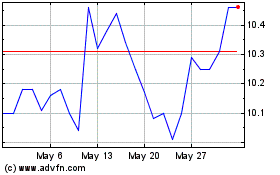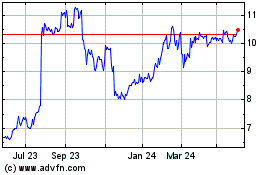Global Stocks Down as Commodities Prices Slip
February 24 2016 - 4:50AM
Dow Jones News
Global stocks fell Wednesday, weighed by fresh declines in
commodities prices and China's currency.
The Stoxx Europe 600 was down 1% in early trade following a weak
finish on Wall Street and in Asia.
Losses were led by the mining and energy sectors as oil and base
metals prices continued their retreat.
Crude oil lost further ground after Saudi Arabia's oil minister
dismissed the possibility of a production cut amid a global supply
glut. Brent crude was down 1.6% at $32.75 a barrel, adding to pain
for the energy sector and its creditors.
Some investors have used the oil price as a gauge of the health
of the global economy, responding to downward moves by selling
risky assets, such as stocks, across the board.
Also keeping investors cautious, Chinese authorities guided the
yuan weaker for a second day in a row. Depreciation of the currency
sent shock waves through financial markets last August and at the
start of this year.
Investors fear a substantially weaker Chinese currency could
spur capital outflows from the country and adversely impact China's
trading partners.
"China remains one of our biggest concerns in global financial
markets," said Barclays economist Shengzu Wang.
The Shanghai Composite Index closed up 0.9%, but shares
elsewhere in Asia fell, catching up with losses in the U.S. and
Europe.
Japan's Nikkei Stock Average was down 0.9% as a stronger yen
weighed on shares of exporters. Bank of Japan Governor Haruhiko
Kuroda said Wednesday that the central bank wouldn't hesitate to
act if market volatility threatens its efforts to defeat deflation,
helping to push long-term Japanese government bond yields to record
lows. Yields fall as prices rise.
Australia's S&P ASX 200 fell 2.1%, weighed down by energy
and financial shares, while Hong Kong's Hang Seng Index lost
1.2%.
Stocks around the world had climbed last week, recouping some of
the steep losses in global financial markets earlier this year. A
slump in bank shares and declining commodity prices halted the
rally Tuesday as Wall Street ended lower.
Mixed U.S. data did little to reassure investors about the
strength of the U.S. economy after consumer confidence figures
disappointed.
The yield on the 10-year Treasury note fell around 0.02 of a
percentage point Wednesday to 1.717%, and is down over half a
percentage point this year.
"The 10-year Treasury is literally telling you the bond market
sees clouds on the horizon," said Bob Andres, chief investment
officer of Andres Capital Management.
Mr. Andres expects stocks to fall further amid a global
slowdown, low commodities prices, and after years of quantitative
easing in the U.S., which he said artificially boosted stock
prices.
In currencies, the dollar was up 0.1% against the yen at ¥
112.0680, while the euro was down 0.2% against the dollar at
$1.0998.
Recent weak manufacturing and business expectations figures in
Europe have further fueled expectations for the European Central
Bank to expand its stimulus measures at its March meeting.
In metals, gold was up 0.3% at $1,226 an ounce.
Copper was down 1.5% at $4,585 a ton, adding to pain in Europe's
basic resources sector. With Wednesday's losses, the mining sector
fell back into negative territory for the year.
Summer Said and Hiroyuki Kachi contributed to this article.
Write to Riva Gold at riva.gold@wsj.com
(END) Dow Jones Newswires
February 24, 2016 04:35 ET (09:35 GMT)
Copyright (c) 2016 Dow Jones & Company, Inc.
Pacific Current (ASX:PAC)
Historical Stock Chart
From May 2024 to Jun 2024

Pacific Current (ASX:PAC)
Historical Stock Chart
From Jun 2023 to Jun 2024
